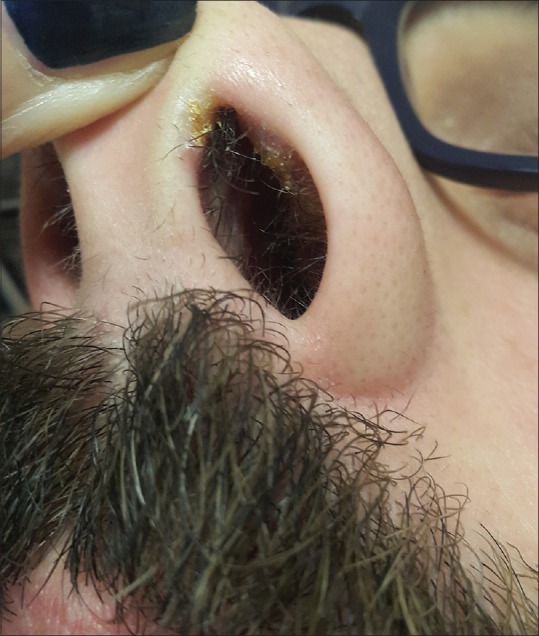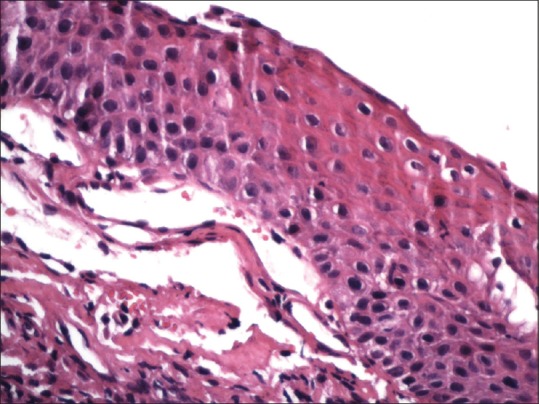Sir,
A 28-year-old Caucasian male patient presented with a 2-year history of asymptomatic, crusted lesions on the nasal mucosa. The past medical history was remarkable for allergic rhinitis. He was treated with topical corticosteroids (mometasone furoate/beclomethasone dipropionate with benzalkonium chloride) twice daily for long periods of time. Dermatological examination revealed yellow-brown crusts and erosions on the nasal mucosa [Figure 1]. Furthermore, rhinoscopic examination revealed widespread white plaques on the nasal mucosa. Candidiasis, pemphigus, and leukoplakia were considered in the differential diagnosis. A mucosal biopsy was performed to reach a definitive diagnosis. Histopathological examination showed disorganized and atypical epithelial cells with hyperchromatic nuclei and eosinophilic cytoplasm and increased mitotic rate in the upper epidermal layers, intact basement membrane, and subepithelial lymphocytic infiltration [Figure 2]. The patient was advised not to use topical corticosteroids for rhinitis. He used isotonic saline solution for nasal irrigation. Nasal mucosal crusts were healed completely within 2 weeks. Close follow-up was recommended to evaluate mucosal dysplasia.
Figure 1.

Crusts on the left nostril
Figure 2.

Atypical epithelial cells with hyperchromatic nuclei and eosinophilic cytoplasm (H and E, ×200)
Sinonasal epithelial malignancies are rare tumors and 10–20% of all cases are adenocarcinomas.[1] Some external factors have been associated with an increased risk of nasal malignancies. Boysen et al. evaluated the nasal mucosal biopsies of a chemical company workers exposed to formaldehyde. Thirty-seven workers and 37 age-matched controls were included in the study. The volunteers had similar smoking habits and nasal diseases. Nasal mucosal hyperplasia was more common in the formaldehyde-exposed group. Therefore, the authors suggested that formaldehyde might play a role in the etiology of epithelial dysplasia.[2] Furthermore, nickel has been considered to be responsible for squamous metaplasia. Boysen et al. showed an increased risk of nasal adenocarcinoma and squamous cell carcinoma in furniture workers.[3] Air pollution has also been associated with dysplastic changes in nasal mucosa.[4] Rhinitis can be treated with topical corticosteroids. Topical nasal corticosteroids are considered harmless, however, some spray forms include benzalkonium chloride as a protective agent. Benzalkonium chloride has been implicated in the development of toxic changes in the respiratory mucosa. Berg et al. evaluated the effect of benzalkonium chloride on the nasal mucosa of rats. They applied corticosteroids with and without benzalkonium chloride to the nostrils twice daily for 21 days. Biopsy specimens of the nasal mucosa exposed to steroids containing benzalkonium chloride revealed squamous cell metaplasia. However, biopsy specimens of the nasal mucosa exposed to steroids without benzalkonium chloride did not show degenerative alterations.[5] Our patient had similar histopathological characteristics. However, a complete clinical response has been achieved by interrupting topical corticosteroid therapy.
The patient we presented had no known risk factors for nasal mucosal dysplasia. However, he had used nasal steroid (mometasone furoate, beclomethasone dipropionate) sprays with benzalkonium chloride for the last 2 years. Therefore, we suggest that long-term use of intranasal corticosteroids with benzalkonium chloride can lead to high-grade dysplasia in the nasal mucosa. We present an unusual case of nasal mucosal dysplasia in an otherwise healthy young man to emphasize the possible side effects of benzalkonium chloride in the upper respiratory tract.
Financial support and sponsorship
Nil.
Conflicts of interest
There are no conflicts of interest.
References
- 1.Palomba A, Iaia TE, Biancalani M, Conti S, Battista G, Papaleo B, et al. Amorphologic and immunohistochemical study of nasal mucosa in leatherworkers. Am J Rhinol. 2008;22:356–60. doi: 10.2500/ajr.2008.22.3201. [DOI] [PubMed] [Google Scholar]
- 2.Boysen M, Zadig E, Digernes V, Abeler V, Reith A. Nasal mucosa in workers exposed to formaldehyde: A pilot study. Br J Ind Med. 1990;47:116–21. doi: 10.1136/oem.47.2.116. [DOI] [PMC free article] [PubMed] [Google Scholar]
- 3.Boysen M, Solberg LA. Changes in the nasal mucosa of furniture workers. A pilot study. Scand J Work Environ Health. 1982;8:273–82. doi: 10.5271/sjweh.2466. [DOI] [PubMed] [Google Scholar]
- 4.Hernández-Escobar SA, Avila-Casado MC, Soto-Abraham V, López Escudero OL, Soto ME, Vega-Bravo ML, et al. Cytological damage of nasal epithelium associated with decreased glutathione peroxidase in residents from a heavily polluted city. Int Arch Occup Environ Health. 2009;82:603–12. doi: 10.1007/s00420-008-0378-1. [DOI] [PubMed] [Google Scholar]
- 5.Berg OH, Lie K, Steinsvåg SK. The effects of topical nasal steroids on rat respiratory mucosa in vivo, with special reference to benzalkonium chloride. Allergy. 1997;52:627–32. doi: 10.1111/j.1398-9995.1997.tb01041.x. [DOI] [PubMed] [Google Scholar]


